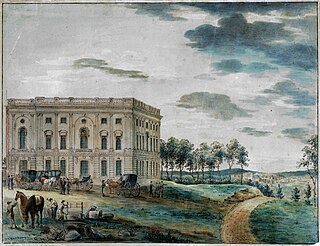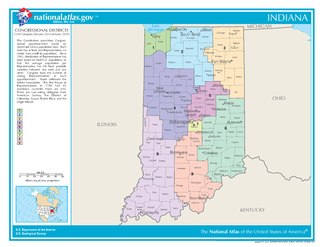It has been requested that the title of this article be changed to List of governors of New York . Please see the relevant discussion on the discussion page. The page should not be moved unless the discussion is closed; summarizing the consensus achieved in support of the move. |

The governor of New York is the head of the executive branch of New York's state government and the commander-in-chief of the state's National Guard. [1] The governor has a duty to enforce state laws, to convene the New York legislature, [1] the power to either approve or veto bills passed by the legislature, [2] and to grant pardons, except in cases of treason and impeachment. [3]

The Governor of New York is the chief executive of the U.S. state of New York. The governor is the head of the executive branch of New York's state government and the commander-in-chief of the state's military and naval forces.

A commander-in-chief, sometimes also called supreme commander, is the person that exercises supreme command and control over an armed forces or a military branch. As a technical term, it refers to military competencies that reside in a country's executive leadership – a head of state or a head of government.

In the United States, a state is a constituent political entity, of which there are currently 50. Bound together in a political union, each state holds governmental jurisdiction over a separate and defined geographic territory and shares its sovereignty with the federal government. Due to this shared sovereignty, Americans are citizens both of the federal republic and of the state in which they reside. State citizenship and residency are flexible, and no government approval is required to move between states, except for persons restricted by certain types of court orders. Four states use the term commonwealth rather than state in their full official names.
Contents
- Governors
- Other high offices held
- Living former Governors of New York
- See also
- Notes
- References
- External links
Fifty-six people have served as governor, four of whom served non-consecutive terms; the official numbering only lists each governor once, so there have officially been fifty-six governors. This numbering includes one acting governor: the lieutenant governor who filled the vacancy after the resignation of the governor, under the 1777 Constitution. [4] The list does not include people who have acted as governor when the governor was out of state, such as Lieutenant Governor Timothy L. Woodruff during Theodore Roosevelt's vice presidential campaign in 1900, or Acting Speaker of the New York State Assembly Moses M. Weinstein, who acted as governor for ten days in 1968 while the governor, the lieutenant governor and the senate majority leader were out of the state, attending the Republican National Convention in Miami. [5]
Moses M. Weinstein was an American lawyer and politician.

Miami, officially the City of Miami, is the cultural, economic and financial center of South Florida. Miami is the seat of Miami-Dade County, the most populous county in Florida. The city covers an area of about 56.6 square miles (147 km2), between the Everglades to the west and Biscayne Bay on the east; with a 2017 estimated population of 463,347, Miami is the sixth most densely populated major city in the United States. The Miami metropolitan area is home to 6.1 million people and the seventh-largest metropolitan area in the nation. Miami's metro area is the second-most populous metropolis in the southeastern United States and fourth-largest urban area in the U.S. Miami has the third tallest skyline in the United States with over 300 high-rises, 80 of which stand taller than 400 feet.
Four men have become President of the United States after serving as Governor of New York: Martin Van Buren, Grover Cleveland, Theodore Roosevelt, and Franklin D. Roosevelt, and six were Vice President of the United States. Van Buren and Theodore Roosevelt held both offices. Two governors have been Chief Justice of the United States: John Jay held that position when he was elected governor in 1795, and Charles Evans Hughes became chief justice in 1930, two decades after leaving the governorship.

The president of the United States (POTUS) is the head of state and head of government of the United States of America. The president directs the executive branch of the federal government and is the commander-in-chief of the United States Armed Forces.

Martin Van Buren (; born Maarten Van Buren was an American statesman who served as the eighth president of the United States from 1837 to 1841. He was the first president born after the independence of the United States from the British Empire. A founder of the Democratic Party, he previously served as the ninth governor of New York, the tenth United States secretary of state, and the eighth vice president of the United States. He won the 1836 presidential election with the endorsement of popular outgoing President Andrew Jackson and the organizational strength of the Democratic Party. He lost his 1840 reelection bid to Whig Party nominee William Henry Harrison, due in part to the poor economic conditions of the Panic of 1837. Later in his life, Van Buren emerged as an elder statesman and important anti-slavery leader, who led the Free Soil Party ticket in the 1848 presidential election.

Stephen Grover Cleveland was an American politician and lawyer who was the 22nd and 24th president of the United States, the only president in American history to serve two non-consecutive terms in office. He won the popular vote for three presidential elections—in 1884, 1888, and 1892—and was one of two Democrats to be elected president during the era of Republican political domination dating from 1861 to 1933.
The longest-serving governor was the first, George Clinton, who first took office on July 30, 1777, and served seven terms in two different periods, totaling just under 21 years in office. As 18 of those years were consecutive, Clinton also served the longest consecutive period in office for a New York governor. Charles Poletti had the shortest term, serving 29 days following the resignation of the previous governor in 1942. The current governor is Democrat Andrew Cuomo, who took office on January 1, 2011.

George Clinton was an American soldier and statesman, considered one of the Founding Fathers of the United States. A prominent Democratic-Republican, Clinton served as the fourth vice president of the United States from 1805 until his death in 1812. He also served as governor of New York from 1777 to 1795 and from 1801 to 1804. Along with John C. Calhoun, he is one of two vice presidents to hold office under two presidents.

Charles Poletti was an American lawyer and politician. He was the 46th Governor of New York in December 1942, and was the first Italian-American governor in the United States.

The Democratic Party is one of the two major contemporary political parties in the United States, along with the Republican Party. Tracing its heritage back to Thomas Jefferson and James Madison's Democratic-Republican Party, the modern-day Democratic Party was founded around 1828 by supporters of Andrew Jackson, making it the world's oldest active political party.































































